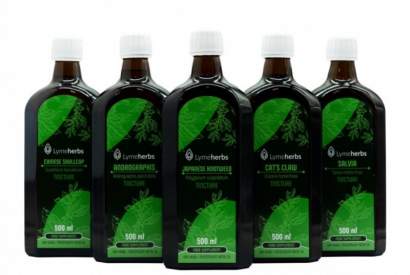
Alcohol Based Herbal Tinctures
Alcohol-based plant tinctures are made by macerating a fresh plant in alcohol or a dried plant in a mixture of alcohol and water. In the case of tinctures of dried plants, water is added due to the fact that plants lose their natural moisture during drying. When making tinctures of a dried plant, add as much water as the plant would contain if it were fresh. The amount of water is selected on the basis of tables detailing the moisture content of the medicinal plant. This makes it possible to extract water-soluble components. This information is important for people who prepare tinctures on their own.
Alcohol is an excellent medium for extracting herbs, and alcohol-based tinctures are the most popular form of herbal use by professional herbalists. Alcohol is an excellent solvent for most herbal ingredients and can be used to make tinctures of fresh or dried plants. Alcohol preparations have the longest shelf life of all herbal extracts, so they can be stored for years, in most cases without losing potency.
Maceration of herbs with alcohol ensures that the active ingredients of herbs are delivered to the bloodstream faster, making tinctures a fast-acting form of taking herbs.
The Lymeherbs store offers two concentrations of tinctures: 1:5 herb strenght ratio and 1:2 herb strenght ratio.
A concentration of 1:5 means that 5 parts of alcohol were used for 1 part of the plant. A concentration of 1:5 is well tolerated by most people. All tincture doses given in the Buhner protocol are for a concentration of 1:5.
With more tinctures used, many people find the amount of alcohol consumed too much. So we introduced tinctures in a concentration of 1:2.
A concentration of 1:2 means that 2 parts of alcohol were used for 1 part of the plant.
Tinctures in a 1:2 concentration are stronger, so you consume less of them and therefore the amount of alcohol consumed decreases significantly. The dose is 2.5 times less than that of a 1:5 tincture. It is a good alternative for people who consume more tinctures and want to limit the amount of alcohol consumed.
If you use the Buhner protocol and you want to use a different concentration of tinctures, it is important to choose the appropriate dose depending on the selected concentration.
You absolutely must remember about a very important thing.
The dosage presented by Buhner works well for most people and is well tolerated. However, your body may react individually and the doses specified in the Buhner Protocol may be too high or too low for you. If you are very sensitive to external substances, you may need to use very small doses, even one to five drops of the tincture 1: 5 at a time. In this case, you may find that a 1:2 concentration is too strong for you. Observe your body. If you feel unwell when taking tincture with 1:2 ratio then go back to a concentration of 1:5.
Due to this reason, the highest concentration we recommend is 1: 2.
The most important herbs from the Buhner Protocol are available as tinctures from the Lymeherbs store:
Alchornea (Alchornea cordifolia)
Andrographis (Andrographis paniculata)
Angelica (Chinese angelica, Latin Angelica sinensis)
Ashwagandha (Indian ginseng, Latin: Withania Somnifera)
Astragalus (Astragalus membranaceus, Latin Astragalus membranceus)
Barberry (Latin Berberis vulgaris)
Bidens (Latin Bidens pilosa)
Boneset (The oversized seedlings, Latin: Eupatorium perfoliatum)
Cat's Claw (Cat's Claw, Latin Uncaria tomentosa)
Chinese Senega (Latin Polygala senega)
Chinese skullcap (Scutellaria baicalensis)
Cordyceps (Latin Cordyceps sinensis)
Cryptolepis (Latin Cryptolepis sanguinolenta)
Echinacea (Echinacea narrow-leaved, Latin Echinacea angustifolia)
Two-necked hawthorn (Latin Crataegus oxyacantha)
Goldenseal (Canadian goldenseal, Latin Hydrastis canadensis)
Gou Teng (Latin Uncaria rhynchophylla)
Houttuynia (Latin Houttuynia cordata)
Isatis (Latin Isatis tinctoria)
Kudzu Root (Latin Pueraria lobata)
Lion’s mane (Latin Hericium erinaceus)
Lomatium Root (Lomatium dissectum)
Licorice (Latin Glycyrrhiza glabra)
Maca (Latin Lepidium meyenii)
Motherwort (motherwort, Latin Leonurus cardiaca)
Pine pollen (Latin Pinus massonia)
Japanese knotweed (Latin Polygonum cuspidatum)
Red Root (American Prusznik, Latin Ceanothus americanus)
Rhodiola (Rhodiola rosea, Latin Rhodiola rosea)
Salvia miltiorrhiza (Red Sage)
Sida acuta
Stephania tetrandra
Tienchi Ginseng (Panax notoginseng)
Korean ginseng (Panax ginseng)
Siberian ginseng (Latin Eleutherococcus senticosus)

 Boosting Your Libido Naturally with Herbal Supplements
Boosting Your Libido Naturally with Herbal Supplements
 Unlocking Energy Potential: Shilajit's Impact on ATP Production and Vitalit
Unlocking Energy Potential: Shilajit's Impact on ATP Production and Vitalit
 Collagen's Role in Lyme Disease Recovery: Understanding Its Vital Benefits
Collagen's Role in Lyme Disease Recovery: Understanding Its Vital Benefits
 Helicobacter Pylori- Natural Treatment
Helicobacter Pylori- Natural Treatment
 Sleep and Immunity
Sleep and Immunity